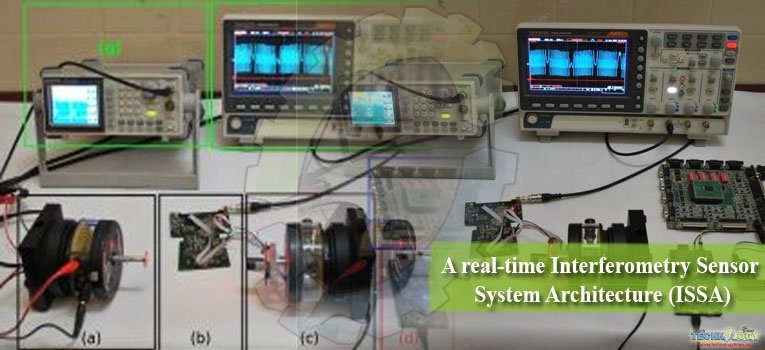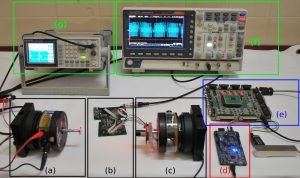Teams of Digital System Design, Sensing and Signal Processing from Riphah Int’l University, NUST, UCERD Pvt Ltd Islamabad and University de Toulouse France, developed a high performance real-time Interferometry Sensor System Architecture (ISSA). Dr. Tassadaq Hussain is the team lead of this project.

The Interferometry Sensor System Architecture (ISSA) takes complex and high-speed signals data from interferometry sensors interface or saved in the memory, handles it in an on-chip memory system and processes them using dedicated hardware accelerators or multi-RISC (Reduced Instruction Set Computer) processor system.
The ISSA provides single-board hardware and software solution for sensor applications, by accessing high-speed data using Front-end Sensor Interface, placing it to local memory and processing it using heterogeneous multi-core processing system. To hide the hardware complexity the ISSA provides sensor applications programming toolkit which provides data transfer, memory management, and processing function calls.

In order to valdate the ISSA three diverse sensor algorithms (CSU, IPUM, and TFSP) are targeted. CSU algorithm is the least precise algorithm among the three algorithms. However, due to the simplest processing, CSU is most efficient in terms of resources, speed, and power consumption. IPUM is a most precise algorithm, but more precision is achieved at cost of more resources, power and time utilization. TFSP is in-between CSU and IPUM in terms of precision, resource utilization, time and power consumption.
Salient contributions of the proposed ISSA are:
• Enables hardware/software co-design and parallel processing approach, by supporting multiple general purpose RISC and application specific hardware accelerator cores.
• Gives high-performance and real-time application support by using a memory system which manages computer intensive and time critical data and their complex transfers.
• Provides hardware reconfigurability by using application specific accelerators which allow sensor system architect to port more features in hardware without changing the system architecture.
• Consumes low power by utilizing a front-end interface that handles multiple sensors and their 1D/2D data transfers.
• Provides energy efficacy and high speed by using an on-chip scheduler which handles multiple sensors and processing cores.
• Offers programming toolkit which helps sensor application programmers to write their code easily and efficiently.
• When compared to a baseline sensor system, the ISSA improves the application performance up to 7.5 times, draws 15.6% less dynamic power and consumes 8.9 times less energy.
Backgroud of Self Mixing Interferometry Sensing System
Most of the time, sensors and devices contact target objects to find vibrations, frequency, motion and their distances such as in accelerometers or power measuring devices. These devices have great advantages because of their low cost, and simple design. However, the use is limited due to two main reason. First, the device contacts with the target object which then changes the frequency characteristics and the movement of the targeted object. The second reason is that usually, the tested devices are difficult to reach or located in a hostile environment.
In this scenario to reach or go near to the target is dangerous for example, during the case of measuring oscillations in high voltage transformers. The alternative for contact vibration sensors is to use the interferometric sensors, which can also be classified as external configurations such as Michelson or Mach-Zender, as well as self-mixing configurations. External interferometric circuitry is not preferable due to its bulky size, high price, and extremely precise alignment. In conclusion, to use self-mixing interference design is the best option.
The self-mixing interference occurs when the laser beam is not optically isolated from an external diffusive or reflective target. Therefore, the outer surface becomes the part of the system as shown in figure 1. The laser beam is directed onto the target object which reflects the beam into the laser cavity. This results in a change in its optical and electrical power. The change is detected by a photo-detector typically, a photodiode from which SMI signal is obtained, containing information about the target i.e. displacement, velocity, and acceleration.
Additionally, when the optical feedback strength (OFS) level changes, the SMI signal exhibits the multimodal behavior by showing a change in its shape. If the optical return is at an optimal level, the sensor will produce a unimodal signal. In the case, if it is dual, the existing mode will change to the bimodal signal and if it is further increased, it will switch to trimodal and so forth.
Furthermore, with the change in the SMI signal shape, the algorithm for extracting information from the vibration of the target must be changed. The appropriate selection of algorithm must be done when the SMI signal randomly changes shape. The SMI signal must be correctly classified to avoid measurement error. The modality appeared in the SMI signal also intensify the resolution of the sensor.
The self-mixing interferometry phenomena used in various fields, a few of them are mentioned below;
Automobile / aerospace quality control
Measurements of displacement, speed and vibration.
Test and diagnose the performance of acoustic/musical instruments.
In the field of metrology.
Surveillance of civil infrastructure
Detection of land mines.
For security reasons; a quality of remote perception by voice.